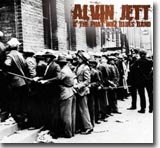 How Long
(Blues Boulevard) is the third Alvin Jett album that I’ve come
across, and the second with the Phat Noize Blues Band –
in 2005 Alvin brought out Wet My Beak, and in 2006
came Milk & Cookies with the band.
How Long
(Blues Boulevard) is the third Alvin Jett album that I’ve come
across, and the second with the Phat Noize Blues Band –
in 2005 Alvin brought out Wet My Beak, and in 2006
came Milk & Cookies with the band.
Unfortunately, if you have the other two CDs, you have
all but one of the 15 tracks featured on this album –
having said that, if you don’t have the first two CDs,
then this is a good way to get a feel for Alvin Jett and
his music.
All of the tracks are originals, mostly written by
either Alvin Jett, or sax player Frank Bauer, or a
combination of the two (apart from “Best Friend You Ever
Had,” written by bass player Matt Davis).
Alvin Jett is a native of East St.Louis, and didn’t
start playing guitar until the age of 20, despite coming
from a musical family. However, it’s pretty obvious that
he grew up listening to a vast amount of music, because
the influences in his music are many and varied.
The tracks on this album encompass just about every
tempo there is, from slow ballad, to hard driving
rocking blues, and there’s something for just about
everyone who likes modern blues.
This is a tight band, with great guitar work from Jett
and marvelous sax playing by Frank Bauer – the quality
of the musicianship shines through.
The album opens with the very appropriately named
“Boogie To The Blues,” a real foot-tapper and a good
opening track – it moves into “Aint Been The Same,”
another up-tempo number, before slowing down with “How
Long,” a track with an insistent bass line that is my favourite on the CD.
From then on the tempo varies from slow ballad, through
medium, to up-tempo. There’s no chance to get bored with
a mix of music like this!
---
Terry Clear
 Here’s a guy who started producing albums back in 1995,
and as far as I can tell this is his 6th. Rob Tognoni was discovered by Australian bluesman Dave
Hole, and he is certainly a fantastic guitar player – no
doubt about it.
Here’s a guy who started producing albums back in 1995,
and as far as I can tell this is his 6th. Rob Tognoni was discovered by Australian bluesman Dave
Hole, and he is certainly a fantastic guitar player – no
doubt about it.
Capital
Wah (Blues Boulevard) is very firmly in the Blues-Rock genre – hard
driving music most of the way through.
Two of the tracks were recorded live in Prague, in the
Czech Republic in 2006 – “Product Of A Southern Land”
and
“Red House,” and they give a good idea of how good this
musician is at playing in front of a live audience.
The version of “Red House” on this album is up among the
best I’ve heard.
The album is a little too much rock
and not enough blues
for my taste, but that’s not to say that it isn’t a good
CD. For those who enjoy hard blues-rock this is a CD
well worth adding to a collection.
---
Terry Clear
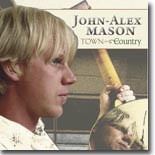 It’s still January as I write this, and already I have a
strong contender for my favourite blues CD of 2008!Town & Country is the first that I’ve heard of John-Alex Mason,
a Colorado native who recorded his album in Boulder, but
I’m hoping that I’ll be hearing a lot more of him.
It’s still January as I write this, and already I have a
strong contender for my favourite blues CD of 2008!Town & Country is the first that I’ve heard of John-Alex Mason,
a Colorado native who recorded his album in Boulder, but
I’m hoping that I’ll be hearing a lot more of him.
Seven of the 15 tracks on the CD are originals, the
remainder being copies of mainly traditional old blues –
it’s not easy to choose between them for a favourite, as
the originals are all well-written and performed.
However, I have (just) managed to pick out a favourite,
and it’s only really because I’ve liked every version of
it that I’ve ever heard, making it just about my
favourite blues song of all time – “Shake ‘Em On Down.”
And, I should be so lucky, there are TWO versions of it
on this CD!!
Some of the original songs are as good as any
traditional old blues, and they show that this musician
has a real feel for the blues, especially traditional
country blues.
The CD opens and closes with versions of “Shake ‘Em On
Down,” which I’ve already made mention of, and then goes
into two Mason originals, “Steel Pony Blues” and “Bury
My Boots.”
The latter could easily be taken from a 1930s bluesman’s
songbook, it has so much atmosphere.
There are covers of “Terraplane Blues” (Robert Johnson),
“Cypress Grove” (Skip James), “Shake Your Moneymaker”
(Elmore James), and the traditional “Jitterbug Swing,”
“Boll Weevil” and “Milk Cow Blues,” and a great mix of
songs written by John Alex Mason.
The feel the
whole way through the CD is of quality, mainly
country-style blues played in an authentic style that
would do credit to many of the big bluesmen of the 40s
and '50s.
To see a photo of John Alex Mason, and then relate the
face to the voice, is very difficult – he looks like a
surfer, but sounds as though he’s at least 60 years old!
But, make no mistake, this guy can write and sing the
blues with the best of them – and he deserves a wide
audience.Buy this CD and enjoy!
---
Terry Clear
 Catherine
Russell's Sentimental Streak (World Village
Music) is just that -- a sentimental look back at an era
when blues and jazz styles came together in classy
mid-town venues. In some ways, it's a tribute to her
father, Luis Russell, a noted jazz pianist who performed
with jazz pioneers King Oliver and Louis Armstrong in
the first half of the 20th century.
Catherine
Russell's Sentimental Streak (World Village
Music) is just that -- a sentimental look back at an era
when blues and jazz styles came together in classy
mid-town venues. In some ways, it's a tribute to her
father, Luis Russell, a noted jazz pianist who performed
with jazz pioneers King Oliver and Louis Armstrong in
the first half of the 20th century.
This homage
begins the album with "So Little Time (So Much To Do),"
based on Armstrong's 1938 recording when Mr. Russell was
Satchmo's musical director. Ms. Russell has just the
right voice for this material --- one can easily imagine
her fronting the band is some WWII-era black and white
movie.
Ms. Russell
also acquits herself well when covering songs from some
of the greatest female singers of the era, such as Pearl
Bailey's "I'm Lazy, That's All," Ella Fitzgerald's "Oh
Yes, Take Another Guess," Alberta Hunter's "My Daddy Got
A Brand New Way To Love" and "You For Me, Me For You"
and Lena Horne's enticing "Thrill Me."
She can also
do more of a down and dirty style, as seen on Bessie
Smith's ribald "Kitchen Man," on which she extols the
virtues of her man's hot jellyroll, his succotash and
turnip tops, and his bologna. Of course, she's not
talking about food here. This song has the sparser
accompaniment of only two guitars (Larry Campbell, Matt
Ministeri) and the tuba of Howard Johnson.
In fact, the
musicians behind Ms. Russell are all very good. They do
just what they are supposed do --- "accompany," not
overwhelm. Where the song, such as the two Alberta
Hunter tunes, requires minimal accompaniment, they
feature only solo musicians, Mark Shane's piano in one
case and Munisteri's guitar on the other.
Providing a
very different sound on two cuts is the inclusion of
Rachelle Garniez's accordion on the slow jazzy Sinatra
number, "South To A Warmer Place," and Garniez's own
composition, "Broken Nose." The accordion is mixed to be
more in the background than the other instruments,
giving these recordings more a "live in a European
courtyard café" feel to them.
The only
criticism of this album is that the recordings sound
just a little too clean and sterile, with not nearly
enough background warmth. I would love to hear these
same songs done in front of a live audience to capture
that missing buzz. For example, Willie Dixon's "I Don't
Care Who Knows" (based on Harold Burrage's version)
cries out for a dirtier, back alley sound.
But overall,
Sentimental Streak is a delightful album that
will please fans of both classic jazz and sophisticated
blues.
--- Bill
Mitchell
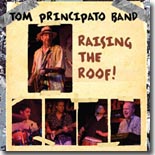 Veteran D.C.
guitarist Tom Principato reinforces his
reputation as one of the better guitarists around with
Raising The Roof! on his own Powerhouse label.
Like Principato's previous releases, this one is a nice
mix of blues, jazz, funk and soul guitar, and backed by
a tight band.
Veteran D.C.
guitarist Tom Principato reinforces his
reputation as one of the better guitarists around with
Raising The Roof! on his own Powerhouse label.
Like Principato's previous releases, this one is a nice
mix of blues, jazz, funk and soul guitar, and backed by
a tight band.
The highlight for me is his cover of Louis Jordan's
"Fish Fry," which sounds so much different from the
original that it would barely be recognizable if not for
he words. Principato takes Jordan's novelty jump blues
and turns it into a slower, funkier interpretation. Very
nice!
Another fun one is the closing number, recorded live,
which reflects every working musician's persistent
frustration with getting the same songs requested from
drunken audience members show after show, night after
night. Played to the tune of the T-Bone Walker classic,
the title, "They Called For 'Stormy Monday' (But
'Mustang Sally' Is Just as Bad!)," introduces the song.
It continues with the following refrain: "'Proud Mary'
is even worse and 'Brown Eyed Girl' is also bad ....
'Free Bird' flies on Friday and Saturday they yelled for
Stevie Ray, I heard 'Little Wing!' cries on Friday and
"Hey what kinda music y'all play? ... On Sunday they
yelled for Jimmy Buffett, but oh that's one we sure as
hell won't play!"
But I
digress. The opening number, "Lock and Key," is an
uptempo number with a New Orleans beat, while the
instrumental, "Too Damn Funky," is reminiscent of the
kind of guitar workouts that the late Danny Gatton used
to stretch out on.
Tommy Lepson
provides sterling Hammond organ accompaniment
throughout, especially on the Jimmy Smith instrumental,
"8 Counts For Rita."
Principato
does some of his best guitar work on the J.J. Cale
original, "Lies," which gets downright funky at times.
Raising The Roof! is a great addition to the vast
Principato catalog. Check out the full selection at
www.powerhouserecords.com.
--- Bill
Mitchell
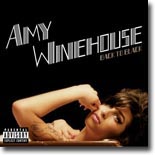 By
now, everyone knows the scoop on Amy Winehouse
--- her often bizarre but always intriguing behavior,
the personal problems that landed her in rehab, the
numerous Grammys awarded to her this past Sunday, etc.
By
now, everyone knows the scoop on Amy Winehouse
--- her often bizarre but always intriguing behavior,
the personal problems that landed her in rehab, the
numerous Grammys awarded to her this past Sunday, etc.
Like many
other middle-aged blues fans, I live in isolation from
most of pop culture. Thus, I was largely oblivious to
Winehouse's music until an eager publicist sent me the
American release of what was soon to be award-winning
CD, Back To Black (Universal Republic),
apparently figuring that it might be appropriate for a
blues CD review site. Yeah, I know, the disc has been
out for a while, but I'm in.
The Grammy
voters did something cool this year. I like this young
woman's eclectic mixture of soul, jazz, R&B, ska and
'60s girl group sound. After receiving this disc three
weeks ago, I popped it into the CD player on my way to
work. First up was the Grammy winner for best song,
"Rehab," which with a vintage R&B groove and the hep cat
background vocalists sounds like it could have been done
by Ruth Brown. I was hooked.
Another
favorite is the energetic anthem "Tears Dry On Their
Own," which sounds so much like Phil Spector's wall of
sound that you will go looking at the liner notes to
make sure that he didn't have anything to do with this
production. But everything here was written or
co-written by Ms. Winehouse. It's really an
autobiographical reading of her chaotic life.
The other
real hero is producer Mark Ronson, who got to share in
the Grammy glory with his own award. The sound that he
captures on every cut is retro but never sounds dated.
Few producers can capture this kind of vibe like Ronson
did on everything cut.
Expand your
horizons. Be cool. Give Back To Black a listen.
--- Bill
Mitchell
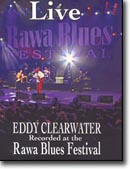 Eddy Clearwater's Recorded Live at the Rawa
Blues Festival (Cleartone Records) isn’t a homemade or amateur DVD; it was produced by
professional cinematographers. The performance was
filmed by Polish National Television and was originally
broadcast on their network. The Poles used multiple
cameras including one on a boom. Since an option did not
appear to select a 5.1 mix, it has been assumed the
audio is only available in stereo. The concert was
filmed at the Rawa Blues Festival, billed as the biggest
indoor blues festival in the world, in Katowice, Poland
on October 9, 2004. From the footage, it appears the
festival is held at an excellent venue. A large crowd,
who are all standing, is shown witnessing Eddy
Clearwater’s antics.
Eddy Clearwater's Recorded Live at the Rawa
Blues Festival (Cleartone Records) isn’t a homemade or amateur DVD; it was produced by
professional cinematographers. The performance was
filmed by Polish National Television and was originally
broadcast on their network. The Poles used multiple
cameras including one on a boom. Since an option did not
appear to select a 5.1 mix, it has been assumed the
audio is only available in stereo. The concert was
filmed at the Rawa Blues Festival, billed as the biggest
indoor blues festival in the world, in Katowice, Poland
on October 9, 2004. From the footage, it appears the
festival is held at an excellent venue. A large crowd,
who are all standing, is shown witnessing Eddy
Clearwater’s antics.
"How," a North American Indian stomp dance song is used to
introduce Eddy “The Chief” Clearwater. He takes the
stage in his trademark full Indian headdress and
replaces it with a cowboy hat halfway through the song.
In typical fashion, the lanky Clearwater is flamboyantly
dressed in bright pants, a white shirt, and boots. Chuck
Berry’s "Sweet Little Rock n Roller" is a classic rock ‘n’
roll song from rock’s golden era, but this rendition
lacks Clearwater’s usual animation. "2x9" has oomph and
drive. Ironically, it sounds like it could have been
written by Berry and comes complete with Berry riffs and
duck walks. Long considered by some to be a Chuck Berry
imitator, Clearwater incorporated rock ‘n’ roll into his
blues after hearing Berry in 1955.
Clearwater’s vocals are tame and a little high-pitched,
but he makes them growl now and then. At times, as on
"Lonesome Feeling" and "Easy Is My Style," Clearwater, who
was born Edward Harrington in Macon, Mississippi on
January 10, 1935, sounds like one of Chicago’s West Side
guitar masters. That’s no surprise, given the fact the
tall southpaw guitarist, who originally performed under
the name of Guitar Eddy, moved to the West Side at age
15. Clearwater’s guitar skills are exceeded by Mark Wydra, who breaks out the slide on
"That’s All Right" and
plays the most famous solo in blues. You know the one
that Muddy Waters and Bob Margolin play so well?
Throughout, Clearwater, named as a word play on Muddy
Waters, regularly smiles and genuinely comes across as
having a great time. For the most part, his supporting
band is potent. The attractive bass-playing Heather
Tackett practically disappears as she stands to the back
and right of the stage. Drummer Merle Perkins is a solid
but weary pounder. Irek Dudek, the Rawa Blues Festival
director, makes a guest appearance on harp.
Clearwater
has always been more about feeling than virtuosity. His
engaging personality will entertain you on this
90-minute DVD. It’s available at Clearwater’s gigs and
his website (www.eddyclearwater.com).
--- Tim Holek
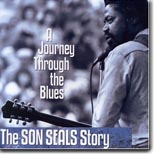 As he says on the
Live and Burning album, Son Seals used
to wake up and say, “Blues.” He had a uniquely
aggressive Chicago sound as exemplified during the
opening moments of this DVD, A Journey Through The Blues – The Son Seals Story
(Vizztone/Sagebrush Productions). From there, the all too
brief 30-minute documentary travels fast via a
structured format. Born Frank "Son" Seals in Osceola,
Arkansas in 1942, Seals is interviewed and reveals the
bare essentials of his life and career. He discusses
growing up in Arkansas and the influence of his father’s
juke joint, The Dipsy Doodle. Regarding why he chose a
life of music, Seals says, “I wanted to do what I saw
other people do.” In 1971, Seals moved to Chicago. Soon
after arriving, he landed regular gigs on the South Side
at The Expressway Lounge and the Flamingo Club.
As he says on the
Live and Burning album, Son Seals used
to wake up and say, “Blues.” He had a uniquely
aggressive Chicago sound as exemplified during the
opening moments of this DVD, A Journey Through The Blues – The Son Seals Story
(Vizztone/Sagebrush Productions). From there, the all too
brief 30-minute documentary travels fast via a
structured format. Born Frank "Son" Seals in Osceola,
Arkansas in 1942, Seals is interviewed and reveals the
bare essentials of his life and career. He discusses
growing up in Arkansas and the influence of his father’s
juke joint, The Dipsy Doodle. Regarding why he chose a
life of music, Seals says, “I wanted to do what I saw
other people do.” In 1971, Seals moved to Chicago. Soon
after arriving, he landed regular gigs on the South Side
at The Expressway Lounge and the Flamingo Club.
Other key figures such as Bruce Iglauer of Alligator
Records, Seals’ sister, Seals’ son, Koko Taylor, and
Frank Pellegrino of Kingston Mines are interviewed.
Producer Peter Carlson, who also made Don't Start Me
Talking (The Junior Wells Story), has resisted using an
all-interview format to tell Seals’ story. The film also
features live performance clips, vintage photos, and
music from several of Seals’ albums.
The two had a business relationship, but most of all
Seals and Iglauer were friends for over 30 years. While
smiling yet visibly distracted (with emotion for the
deceased musician), Iglauer catches himself, “Talking
about him [Seals] in the present tense. His performances
are so alive to me.” Iglauer also reflects on the
grueling life of a traveling bluesman. “Nobody gets rich
playing the blues. If you’re lucky you end up with a
middle class lifestyle. If you are unlucky, you end up a
broke old man.” Whether or not Seals was lucky isn’t
given clarified, but the documentary does confirm Seals
lead a life of hardship.
He became diabetic in the ’70s. In 1997, a former spouse
shot him in the face. Seals survived but the bullet
permanently lodged itself in his skull. Emotionally, his
sister reveals how he started to give up when a portion
of a leg was amputated in 1999. Then he required
dialysis treatments. He did them for a long time but
decided to stop. Son Seals died in 2004. Throughout his
career, Seals externally released his internal
frustrations via his fierce music. Carlson suggests,
“Son Seals took some of your pain and made it his own.
And … at least you weren’t alone with it.”
Commendably, the DVD presents the trials and
tribulations of Seals’ life and career in chronological
order. However, this documentary is so short it views
like you are watching a music magazine’s feature story.
Three bonus live performances, with poor video and audio
quality, do not reflect the power and intensity of Seals
in concert. Thus, this DVD may not entice new listeners
to discover the ferocious electric blues guitar of Son
Seals. Still, it gives a dramatic glimpse into the life
that enabled Seals to create burning blues from deep
within him. On "Nobody Wants A Loser," Seals sang “The
game of life is the hardest one to win.” Iglauer puts it
all into perspective. “His life was a big fight and his
music was his victory when he didn’t win other parts of
that fight.”
--- Tim Holek
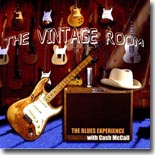 Cash McCall (aka Morris Dollison, Jr.) got his start in
the blues as a session guitarist for Willie Dixon at
Chess Records in the early ’60s and as a songwriter for
Muddy Waters, Howlin’ Wolf, and Little Milton. Dollison
acquired his professional name after Thomas Records
released a demo without his knowledge using the McCall
moniker that he recorded in 1966 titled “When You Wake
Up,” which became a surprise national hit. “That’s How
It Is,” one of Otis Clay’s biggest hits, also came from
McCall’s pen. In recent years, he played with Dixon’s
Chicago All-Stars, the Chicago Rhythm & Blues Kings,
singer Big Twist and the Chicago Blues Review, in
addition to pursuing his own solo career.
Cash McCall (aka Morris Dollison, Jr.) got his start in
the blues as a session guitarist for Willie Dixon at
Chess Records in the early ’60s and as a songwriter for
Muddy Waters, Howlin’ Wolf, and Little Milton. Dollison
acquired his professional name after Thomas Records
released a demo without his knowledge using the McCall
moniker that he recorded in 1966 titled “When You Wake
Up,” which became a surprise national hit. “That’s How
It Is,” one of Otis Clay’s biggest hits, also came from
McCall’s pen. In recent years, he played with Dixon’s
Chicago All-Stars, the Chicago Rhythm & Blues Kings,
singer Big Twist and the Chicago Blues Review, in
addition to pursuing his own solo career.
Dixon’s grandson, Alex, learned to play piano from
Chicago legends Leonard “Baby Doo” Caston and Lafayette
Leake. He also performed with his grandfather and even
co-wrote songs on Dixon’s last CD, Hidden Charms (which
McCall co-produced). The younger Dixon recently formed
Dixon Landing Music, and teamed with McCall to form The
Blues Experience.
Their debut release, The Vintage Room,
is an exhilarating shot of Chicago Blues.Appropriately, the band covers three classic Willie
Dixon tunes, “I Just Want To Make Love To You,” “I’m
Ready,” and “Bring It On Home,” all of which will be
familiar to blues fans. Alex Dixon wrote seven of the
remaining eight originals. Standouts include “Gypsy
Woman,” featuring superb harmonica from Steve Bell, son
of the late Carey Bell, and the clever “Slice Of That
Pie.” Dixon’s songs successfully capture the same spirit
and energy of his grandfather’s compositions.
McCall contributes “Mama,” a reflective soul number, and
his gritty, soulful vocals are right on the mark
throughout the disc, as is his guitar work. In addition
to Bell, also contributing excellent musical support are
Bill “Young Blood” Learned and Katy J on rhythm guitars,
Brady Wills on bass, and Vinnie Threats on drums, with
Dylan Cooper guesting on upright bass for a couple of
tracks.
The Willie Dixon legacy is alive and well, thanks to
Dixon's grandson Alex Dixon, Cash McCall, and The Blues
Experience. The Vintage Room is loaded with songs and
performances that remind you of those legendary Chess
sessions of the '50s and late '60s. They don't make them
like this any more.
--- Graham
Clarke
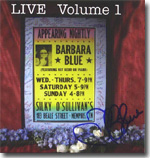 Barbara Blue has played a regular gig at Silky
O’Sullivan’s on Beale Street for the past decade, and
has become a Memphis must-see during that time. She’s
released four excellent albums, the last three with the
Phantom Blues Band in support, and even picked up a 2007
Blues Music Awards nomination as Contemporary Female
Blues Artist of the Year. In addition, the UK’s Shout
Records recently released an import compilation culling
highlights from her four albums. A powerhouse singer
with great stage presence, it seems only appropriate to
capture Blue in her element, so she’s released LIVE
Volume 1 on her own Big Blue Records.
Barbara Blue has played a regular gig at Silky
O’Sullivan’s on Beale Street for the past decade, and
has become a Memphis must-see during that time. She’s
released four excellent albums, the last three with the
Phantom Blues Band in support, and even picked up a 2007
Blues Music Awards nomination as Contemporary Female
Blues Artist of the Year. In addition, the UK’s Shout
Records recently released an import compilation culling
highlights from her four albums. A powerhouse singer
with great stage presence, it seems only appropriate to
capture Blue in her element, so she’s released LIVE
Volume 1 on her own Big Blue Records.
Slated as the first of three releases,
LIVE Volume 1 was
recorded in October and November of 2007, and presents
Blue’s sparkling take on some classic tunes (“Hound
Dog,” Sippie Wallace’s “Woman Be Wise,” Koko Taylor’s
“Wang Dang Doodle,” “Stormy Monday,” and “Lose Your Good
Thing”) along with some favorites from her previous
releases (“The Road Comes To Me,” “Someday Someway,”
“Can’t Get Your Loving Off Of My Mind,” “Toolbox Blues,”
and “Rainy Night In Memphis”).
Blue sounds fantastic. Her vocals range from big and
brassy to smoky and seductive. Her interplay with the
audience is confident and relaxed. Her working band is
first-rate and includes her longtime piano man Nat Kerr,
guitarist Corey Osborn, and Lannie McMillan on
saxophone. Kerr, Nancy Apple, and Reba Russell
contribute backing vocals.
It all adds up to another great release from Barbara
Blue, who has developed into one of the most talented
female blues singers working these days. It will be
interesting to see what the upcoming Volumes 2 and 3
have to offer. They’ll be hard-pressed to top LIVE
Volume 1.
--- Graham
Clarke